Jewish History Books for Young Adults: The Holocaust (Page 6) |
If you wish to purchase any of these books, click on either the title or the book cover to be directed to Amazon.com. As a warning, I have put up pictures of the book covers to give you somewhat an idea of the style of each book (I know, I know. "Don't judge a book by its cover") so the pages may load slowly, depending on the speed of your internet connection.
If this page came up without frames, Click here to see the complete website
NOTE: For biographies of individuals associated with the Holocaust (Anne Frank,
Simon Wiesenthal, etc.), go to the
Biographies
For historical fiction books that take place during the Holocaust, go to the
Holocaust Historical Fiction Books Page
For Holocaust books for younger readers, go to the Children's History Page
Other Pages of Interest:
Holocaust History Books For Middle School and Young Adult Readers ...
(Page 1)
(Page 2)
(Page 3)
(Page 4)
(Page 5)
(Page 6)
Holocaust Historical Fiction Books For Middle School and Young Adult Readers ...
(Page 1)
(Page 2)
(Page 3)
(Page 4)
(Page 5)
(Page 6)
Middle School and YA Books ...
Bar Mitzvah Books |
Jewish Fiction |
Historical Fiction |
Torah Study |
Prayer and Jewish Life Books |
Jewish Holidays |
Jewish Biographies |
Jewish History Books |
Holocaust Books for Teens |
Israel Books
Jewish Historical Fiction for Middle School and YA Readers...
Biblical Era |
Middle Ages, Renaissance, and the Spanish Inquisition |
Immigration & The American Experience |
European History |
Holocaust
(Page 1)
(Page 2)
(Page 3)
(Page 4)
(Page 5)
(Page 6) |
Israel
Jewish History Books for Middle School and Young Adult Readers ...
General Jewish History & Nonfiction |
Biblical Era |
European History (Excluding the Holocaust) |
Immigration & The American Experience |
Holocaust |
Israel
Easy Reader and Picture Books ...
Jewish Children's Books (General) |
Jewish Board Books |
Biblical Stories for Children |
Jewish Holiday Books |
Jewish Family Cookbooks |
Folktales and Talmudic Stories for Children |
Jewish Life Books (Mitzvot, Keeping Kosher, etc.) |
Jewish Life Cycle Books |
Family Haggadahs |
Children's Prayerbooks |
Introductory Hebrew Books |
Jewish History and Historical Fiction Picture Books |
Israel Books
And More ...
Jewish Books for Children |
Bar Mitzvah Books |
Jewish Parenting Books |
Hanukkah Books |
Jewish Music for Children |
Jewish Videos |
Jewish Toys and Gifts |
Jewish Gift Baskets and Gourmet Food |
Jewish Jewelry |
Amazon.com Coupons, Promotions, and Sales
NOTE: For biographies of individuals associated with the Holocaust (Anne Frank,
Simon Wiesenthal, etc.), go to the
Biographies
For historical fiction books that take place during the Holocaust, go to the
Holocaust Historical Fiction Books Page
For Holocaust books for younger readers, go to the Children's History Page
Other Pages of Interest:
Holocaust History Books For Middle School and Young Adult Readers ...
(Page 1)
(Page 2)
(Page 3)
(Page 4)
(Page 5)
(Page 6)
Holocaust Historical Fiction Books For Middle School and Young Adult Readers ...
(Page 1)
(Page 2)
(Page 3)
(Page 4)
(Page 5)
(Page 6)
Middle School and YA Books ...
Bar Mitzvah Books |
Jewish Fiction |
Historical Fiction |
Torah Study |
Prayer and Jewish Life Books |
Jewish Holidays |
Jewish Biographies |
Jewish History Books |
Holocaust Books for Teens |
Israel Books
Jewish Historical Fiction for Middle School and YA Readers...
Biblical Era |
Middle Ages, Renaissance, and the Spanish Inquisition |
Immigration & The American Experience |
European History |
Holocaust
(Page 1)
(Page 2)
(Page 3)
(Page 4)
(Page 5)
(Page 6) |
Israel
Jewish History Books for Middle School and Young Adult Readers ...
General Jewish History & Nonfiction |
Biblical Era |
European History (Excluding the Holocaust) |
Immigration & The American Experience |
Holocaust |
Israel
Easy Reader and Picture Books ...
Jewish Children's Books (General) |
Jewish Board Books |
Biblical Stories for Children |
Jewish Holiday Books |
Jewish Family Cookbooks |
Folktales and Talmudic Stories for Children |
Jewish Life Books (Mitzvot, Keeping Kosher, etc.) |
Jewish Life Cycle Books |
Family Haggadahs |
Children's Prayerbooks |
Introductory Hebrew Books |
Jewish History and Historical Fiction Picture Books |
Israel Books
And More ...
Jewish Books for Children |
Bar Mitzvah Books |
Jewish Parenting Books |
Hanukkah Books |
Jewish Music for Children |
Jewish Videos |
Jewish Toys and Gifts |
Jewish Gift Baskets and Gourmet Food |
Jewish Jewelry |
Amazon.com Coupons, Promotions, and Sales
Other Pages of Interest:
Holocaust History Books For Middle School and Young Adult Readers ...
(Page 1)
(Page 2)
(Page 3)
(Page 4)
(Page 5)
(Page 6)
Holocaust Historical Fiction Books For Middle School and Young Adult Readers ...
(Page 1)
(Page 2)
(Page 3)
(Page 4)
(Page 5)
(Page 6)
Middle School and YA Books ...
Bar Mitzvah Books |
Jewish Fiction |
Historical Fiction |
Torah Study |
Prayer and Jewish Life Books |
Jewish Holidays |
Jewish Biographies |
Jewish History Books |
Holocaust Books for Teens |
Israel Books
Jewish Historical Fiction for Middle School and YA Readers...
Biblical Era |
Middle Ages, Renaissance, and the Spanish Inquisition |
Immigration & The American Experience |
European History |
Holocaust
(Page 1)
(Page 2)
(Page 3)
(Page 4)
(Page 5)
(Page 6) |
Israel
Jewish History Books for Middle School and Young Adult Readers ...
General Jewish History & Nonfiction |
Biblical Era |
European History (Excluding the Holocaust) |
Immigration & The American Experience |
Holocaust |
Israel
Easy Reader and Picture Books ...
Jewish Children's Books (General) |
Jewish Board Books |
Biblical Stories for Children |
Jewish Holiday Books |
Jewish Family Cookbooks |
Folktales and Talmudic Stories for Children |
Jewish Life Books (Mitzvot, Keeping Kosher, etc.) |
Jewish Life Cycle Books |
Family Haggadahs |
Children's Prayerbooks |
Introductory Hebrew Books |
Jewish History and Historical Fiction Picture Books |
Israel Books
And More ...
Jewish Books for Children |
Bar Mitzvah Books |
Jewish Parenting Books |
Hanukkah Books |
Jewish Music for Children |
Jewish Videos |
Jewish Toys and Gifts |
Jewish Gift Baskets and Gourmet Food |
Jewish Jewelry |
Amazon.com Coupons, Promotions, and Sales
Holocaust Historical Fiction Books For Middle School and Young Adult Readers ... (Page 1) (Page 2) (Page 3) (Page 4) (Page 5) (Page 6)
Middle School and YA Books ... Bar Mitzvah Books | Jewish Fiction | Historical Fiction | Torah Study | Prayer and Jewish Life Books | Jewish Holidays | Jewish Biographies | Jewish History Books | Holocaust Books for Teens | Israel Books
Jewish Historical Fiction for Middle School and YA Readers... Biblical Era | Middle Ages, Renaissance, and the Spanish Inquisition | Immigration & The American Experience | European History | Holocaust (Page 1) (Page 2) (Page 3) (Page 4) (Page 5) (Page 6) | Israel
Jewish History Books for Middle School and Young Adult Readers ... General Jewish History & Nonfiction | Biblical Era | European History (Excluding the Holocaust) | Immigration & The American Experience | Holocaust | Israel
Easy Reader and Picture Books ... Jewish Children's Books (General) | Jewish Board Books | Biblical Stories for Children | Jewish Holiday Books | Jewish Family Cookbooks | Folktales and Talmudic Stories for Children | Jewish Life Books (Mitzvot, Keeping Kosher, etc.) | Jewish Life Cycle Books | Family Haggadahs | Children's Prayerbooks | Introductory Hebrew Books | Jewish History and Historical Fiction Picture Books | Israel Books
And More ... Jewish Books for Children | Bar Mitzvah Books | Jewish Parenting Books | Hanukkah Books | Jewish Music for Children | Jewish Videos | Jewish Toys and Gifts | Jewish Gift Baskets and Gourmet Food | Jewish Jewelry | Amazon.com Coupons, Promotions, and Sales
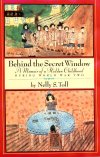 Behind the Secret Window: A Memoir of a Hidden Childhood During World War Two By Nellie S. Toll |
For thirteen months during World War II, Nelly Toll and her mother were hidden from the Nazis in the small bedroom of a Gentile couple in Lwow, Poland. Just eight years old when she went into hiding in 1943, Nelly began keeping the diary that would inspire this powerful and moving memoir of her childhood. In her small black journal Nelly wrote about the heartbreaking events she experienced in Lwow and her grief over the tragic losses of family members, as well as the day-to-day fears of life in hiding. In contrast, the exuberant, vividly colored paintings that Nelly also produced while in hiding transformed her grim reality into an enchanting fantasy world filled with school friends, bright skies, and happy families. Twenty-nine of these paintings are reproduced in Behind the Secret Window; captions help readers to trace the fascinating process of their creation. Together, text and art tell the story of a lovable, imaginative child beset with terrifying uncertainties, and of the courageous mother who nurtured her daughter's unswerving belief in brighter days ahead.
In Toll's remembrance, art equals hope: her happy family pictures, painted in the secret room where she and her mother hid from the Nazis and the Poles, show extraordinary preteen talent (some of the 29 powerfully evocative paintings reproduced here now hang in Yad Vashem, the Holocaust memorial in Israel) as well as the will to survive. Nelly's plight--going from bonbons served on silver platters to hiding behind false walls--was not atypical. In some ways reminiscent of Maus, this emotionally complex and informative memoir reports the willingness of some neighbors to turn in Jews for a bag of potatoes and a bottle of vodka. Adults are keenly observed: a tutor nearly becomes a sex offender; the paranoid man who hides Nelly is both horrifying (wife-beating) and funny (he parades through town with a stack of hats on his head, … la Caps for Sale). The poignancy is heightened by evocative language ("minutes walked by with small steps") and raw emotional hunger ("waiting, waiting for Papa"), and by the postwar rush to reconstitute families by swift remarriages--not seen in many Holocaust books, but an important aspect of healing (Ruth Minsky Sender's To Life). Toll was only six years old when the Nazis marched into her native Lwow (Poland) in 1941. Although her childhood had been shattered two years earlier by the advent of the Russian Army, she and her family were to undergo the full depredations of the Nazis' anti-Semitism. In a remarkably even yet childlike tone, Toll describes persecution by neighbors and former servants as well as the Germans, and we watch as her world shrinks, from an affluent home to cramped quarters in a ghetto to a tiny, hidden room in the Gentile part of town. With her mother, Toll spent more than a year in hiding, dependent on the goodwill of their mercurial Polish patrons, who more than once lost their courage and almost evicted the refugees. While her mother fended off the unwanted attentions of their host and while everyone dodged the suspicions of neighbors, Toll wrote stories and painted pictures, conjuring for herself the pleasures of a normal childhood. Twenty-nine of her watercolors are included here; their poignancy is matched only by the art in I Never Saw Another Butterfly. Without emphasizing horror and loss, Toll conveys the effects of human evil and human folly, summoning up the forces of tragedy and courage. Toll's harrowing account of her family's experiences during and immediately following World War II joins a growing body of Holocaust literature for young adults. Toll was born into a wealthy Jewish family in Lwow, Poland, and her narrative begins in June_ 1941, when the Germans ousted the Russians from her town. To escape transportation to Siberia, her father had been in hiding since 1939. When the Germans began imposing sanctions on the Jews and herding them into a ghetto, he began making plans to hide his family. After her four-year-old brother was taken away in a raid on the ghetto, Toll and her mother joined a group trying to reach Hungary. Victimized by the Germans, they barely escaped a massacre. In 1943, a Christian couple agreed to hide them, and Toll, with her mother, began a nightmarish stay in a hidden room, uncertain of the fate of her father. Toll writes of her experiences in an emotionally controlled, thoughtful manner that only serves to emphasize the horrors she experienced. She relies extensively on a diary she began when she entered hiding at the age of eight, and her story is illustrated with full-color paintings she made during the same period. A fine addition to all school and library collections, this will be especially valuable where Holocaust studies are mandated. |
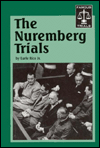 The Nuremberg Trials By Earle Rice, Jr. |
This highly readable, well-honed account records the events that led up to the trial of the 22 major Nazi war criminals by the International Military Tribunal (IMT), the trial itself, and its lasting importance. Through the judicious use of trial transcripts, Rice delineates the atrocities that the defendants were accused of perpetrating upon the peoples of Europe. The legacy of Nuremberg, states Rice, is that "the trials documented Nazi crimes for posterity" and "led to the establishment of a democratic government in postwar [West] Germany." On the other hand, he continues, "Charges of ex post facto law, the lack of legitimate jurisdiction, and victors' justice persist in marring the bright intentions of the Nuremberg proceedings." The author also notes that there has not been the establishment of any permanent and effective international tribunal or court for the trying of Nazi-like criminals. Captioned, archival black-and-white photographs are effectively used throughout, as are elucidating sidebars; a helpful glossary, time line, and index are appended. An information-packed title that complements Gail Stewart's Hitler's Reich.
Part of the Famous Trials series, this dense, informative account examines the 1945-46 Nuremberg trial that tried and executed Nazi war criminals. It begins with the first reports of Nazi atrocities coming out of Eastern Europe in 1940 and goes on to detail the legal aspects of this unprecedented case, including the conflicts between the four participating Allied powers. The historical legacy of the trials is also discussed. Although there is a glossary, the text doesn't always provide sufficient background information about World War II. The book is most compelling when it focuses on the sometimes graphic testimony of the participants, from the evil Goering and contrite Speer to their surviving victims. The up-to-date, annotated bibliography is excellent. However, the black-and-white photos are lackluster. Given the increasing prominence of the Holocaust in the curriculum and the ongoing Hague Tribunal, this is a timely and useful resource. |
 The Holocaust Overview By Ann Byers |
In this introductory volume to the Holocaust Remembered series, Byers presents a comprehensive and dramatic history of the Holocaust aimed at middle-schoolers. Tracing anti-Semitism back to its earliest expression Byers shows how hatred against th e Jews, coupled with the rise of National Socialism, provided the force that swept Adolf Hitler to power. She makes clear that, from the very beginning, Hitler methodically conducted a reign of terror against European Jews: boycotts of Jewish businesses, harassment conducted on city streets, the creation of the Nuremburg Laws, and much more. She also outlines the four-part strategy to eliminate the Jews: exclusion, expulsion, enclosure, and ultimately, extermination. Numerous black-and-white period photog raphs provide evidence of the horrors of WWII. This is a solid introduction to the series, but is also effective as a stand-alone volume, a starting point in the curriculum.
In The Holocaust Overview, author Ann Byers analyzes the Holocaust’s horrific legacy–the murder of nearly six million Jews. She also traces the factors that led to the rise and fall of Germany’s Third Reich. |
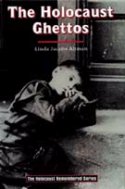 Holocaust Ghettos By Linda Jacobs Altman |
The Holocaust Ghettos details the Jewish ghettos that were established in Europe during the Holocaust. The ghettos were set up by the Nazi state to segregate the Jews from other members of the population. The author describes how the Jews kept alive their cultural and religious lives despite the poverty and hardships of ghetto life under Nazi rule. Also included are accounts of the revolts by those who dared to fight back.
|
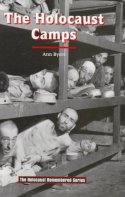 The Holocaust Camps By Ann Byers |
The Holocaust Camps details the system of concentration camps set up by the Nazis in Europe during the Holocaust. Byers recounts the horrifying conditions suffered by camp inmates as well as their struggles for life and hope in a world gone mad. The camps still standing today serve as a chilling reminder of the Holocaust.
|
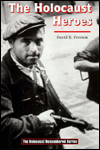 The Holocaust Heroes By David K. Fremon |
The Holocaust Heroes recounts the actions some people took to save
the lives of thousands of people trying to escape from the Nazis and their deadly
persecution. Author David K. Fremon describes the bravery of the many who risked
their own lives to save others during the Holocaust. Their heroic activities ranged
from forging false identity papers to leaving out food for refugees to hiding Jews
in their homes.
Holocaust Heroes is an on-target, accurate overview of the men and women who risked their lives to save thousands of Jews. Among the stories recounted are those of Kate Rossi, a teenage French Resistance worker who guided refugees to safety; Marian Pritchard, who shot the Dutch policeman who came searching for her charges; the Committee for the Defense of the Jews in Belgium, which saved more than 3000 children; and Raoul Wallenberg, who rescued Hungarian Jews. Survivors gives eyewitness accounts of the lives of concentration camp victims after liberation. The physical and psychological effects of the war, the search for family members, and beginning a new life are all discussed. Trials of major Nazi leaders at Nuremberg are also examined as is America's use of Nazi scientists during the perceived forthcoming fight against Communism. The creation of Israel and the importance of teaching about the Holocaust are both covered intelligently. |
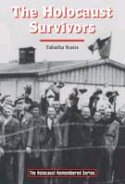 The Holocaust Survivors By Tabatha Yeatts |
The Holocaust Survivors details the harsh stories of those who lived through the Holocaust. For most survivors, life continued to be bleak after the war since they had neither homes nor families to which they could return. Yeatts not only concentrates on the aftermath’s effect on survivors, but on the fate of those responsible for the Holocaust as well.
Tabatha Yeatts's book, The Holocaust Survivors, provides an astute glimpse into one of history's most difficult chapters. The author establishes an historical context for her story with a brief summary of the Holocaust. She goes on to relate the experiences of survivors as well as addressing issues and aims of the Nuremberg trials and the task to establish an independent state of Israel. Yeatts skillfully blends broad, often harsh, themes with convincing, intimate detail. The result is a carefully balanced narrative that communicates the magnitude of events without overwhelming the reader. Her sensitive retelling of individual tragedies respects the human dignity that is the victims' due. Yeatts also includes a chapter devoted to continued efforts to seek justice for wrongs committed by Nazi war criminals. Finally, she concludes with an intriguing discussion of individual character traits, attitudes, and mindset that predispose individuals to turn into rescuers, bystanders, or contributors when evil groups threaten a society. Yeatts's book, always timely, will never be more so than in this year [2000] when Passover coincides with Hitler's birthday. |
 A Place to Hide: True Stories of Holocaust Rescues By Jayne Pettit |
A collection of true accounts of the rescue of Jews during the Holocaust
describes the hiding of Anne Frank and her family in Amsterdam,
businessman Oskar Schindler's rescue of Jews, and Jewish refugees hidden
in Assisi, Italy's monastery.
|
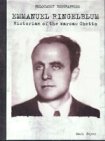 Emmanuel Ringelblum: Historian of the Warsaw Ghetto By Mark Beyer |
The Warsaw ghetto was not only a vibrant community full of culture and tradition, but it became a prison for Polish Jews during World War II. Emmanuel Ringelblum was a resident who found a unique way of fighting injustice. His tireless efforts to record the life experience of the ghetto residents resulted in the Oneg Shabbat archives.
Jewish resistance in the Warsaw Ghetto is the focus of these titles in the new Holocaust Biographies series. Filled with heart-wrenching quotes from ghetto residents, they discuss the history as much as the individual heroes. Beyer's fine biography of Ringelblum tells how Ringelblum secretly collected eyewitness accounts and recorded what was happening as the Nazis closed in ... Spacious type, wide margins, occasional subheads, and black-and-white photos make the books quite readable, and each volume includes a brief list of books and Web sites. |
 Mordechai Anielewicz: Hero of the Warsaw Ghetto Uprising By Kerry P. Callahan |
Young readers may not be aware of any cases of Jews fighting back. In fact, there was a substantial youth movement whose members were willing to sacrifice their own lives in order to launch a resistance movement against the Nazis. This book examines the life and death of Mordechai Anielewicz, a young Jew who led armed resistance struggles against Nazi captors.
|
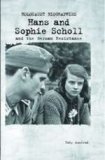 Hans and Sophie Scholl: German Resisters of the White Rose By Toby Axelrod |
During the worst years of Nazi rule, it seemed as if all of German society had lost its moral bearing. Yet with nothing personal to be gained and everything to be lost, there were heroic individuals such as the Scholls, who resisted Hitler's diabolical regime, sacrificing themselves in order to save others.
These books examine the lives of three people who were involved in the Nazi war on civilians during World War II. The Scholls were German siblings who helped to organize and lead the German resistance group called the White Rose. With other brave college friends, they secretly printed and disseminated a series of leaflets exposing the aims and evils of the Nazi government, resulting in their arrest, execution, and martyrdom. |
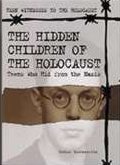 The Hidden Children of the Holocaust By Esther Kustanowitz |
During the Holocaust, many Jewish teens went into hiding-in homes, in barns, in the woods-to avoid being captured and killed. Others managed to disguise themselves as non-Jews. This book explores their experiences and feelings when hiding from the Nazis.
By amplifying the individual voices of teenagers directly affected by the Holocuast, these books give memorable witness to a defining period in European history. |
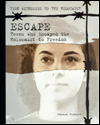 Escape Teens Who Escaped the Holocaust to Freedom By Sandra Giddens |
Some Jewish teens were fortunate enough to escape Nazi-controlled territory, sometimes alone and often with little but the clothes on their backs. This volume focuses on how four teens eluded and escaped from the Nazis.
By amplifying the individual voices of teenagers directly affected by the Holocuast, these books give memorable witness to a defining period in European history. A plethora of material on the Holocaust has been published--is there room for more? Yes, if the material serves to inform in a compelling way and this eight-volume series does just that. By amplifying the individual voices of teenagers directly affected by the Holocaust, these books give memorable witness to a defining period in modern European history. Within the confines of around sixty pages, each book extensively quotes witnesses to the historical events and also includes a discussion of Hitler's rise to power, with emphasis on his racial theories and persecution of the Jews. Four or five individuals' stories are told in each book. Black-and-white photos and an innovative layout of text over superimposed photos heighten the starkness of the narrative and the truthfulness of these witnesses. In brevity, design, and content these books will appeal to young adult readers. Escape chronicles the lives of "four survivors who escaped out of the maze to freedom," the maze being the trap of confinement that surrounded European Jews. Two came from religious Jewish families, two were more secularized. Each shared a strong commitment to family and an invincible will. In their accounts readers will be impressed by the heartbreak of family separation that was usually the experience of survivors: one saved, others lost, their fates unknown until much later. What on the surface appeared to be chance circumstances often meant the difference between life and death for individual members of a family. While the help of others outside of the Jewish community was necessary in some form, for individuals to escape, forms of resistance depended primarily on the will of individual Jews. In Resistance readers are introduced to three forms of resistance: armed, unarmed, and spiritual. The accounts of the armed resistance of Jewish partisan groups are fascinating but just as interesting are the courageous efforts of unarmed Jewish workers to sabotage Nazi munitions factories. The dangerous work of couriers and the spiritual resistance of those who kept their faith and religious practices are also described. Liberation contrasts with the other two volumes in that non-Jewish soldiers are among the speakers. A black soldier who had himself encountered prejudice feels a special empathy and compassion for the plight of the survivors. A young white soldier finds it difficult to sleep for days after viewing Nazi atrocities. The soldiers were unprepared for the camps and, like survivors, often resisted telling others what they had seen. Now they are beginning to speak up as compelling witnesses to the horrors of the Holocaust. Highly recommended for both format and content, this series will be useful in all libraries. Other titles in the series are In the Ghettos, The Hidden Children of the Holocaust, Rescuers Defying the Nazis, In the Camps, and The Hitler Youth. |
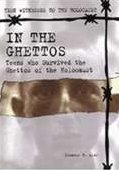 In The Ghettos Teens Who Survived the Ghettos By Eleanor H. Ayer |
The Nazis confined most European Jews in ghettos, where food, housing, and heat were in short supply, before deporting them to concentration camps. How teenagers maintained hope and dignity despite the deprivation of the ghettos is vividly related in this book.
By amplifying the individual voices of teenagers directly affected by the Holocuast, these books give memorable witness to a defining period in European history. |
|
In the Camps Teens Who Survived the Nazi Concentration Camps By Toby Axelrod |
Millions of people perished in the Nazi concentration camps. Teens were among those who most often survived. This book tells their stories of despair, sadness, and the hope that they maintained despite the horror of the camps.
Highly recommended for both format and content, this series will be useful in all libraries. By amplifying the individual voices of teenagers directly affected by the Holocuast, these books give memorable witness to a defining period in European history. Ideal for classroom research projects. This title in the series will be a worthy addition to school libraries. |
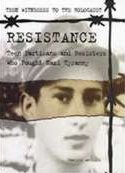 Resistance Teen Partisans and Resisters Who Fought Nazi Tyranny By Charles Anflick |
Teenagers were among those most likely to resist the Nazis in ghettos and concentration camps. Their armed and unarmed resistance against the Nazis, as well as their spiritual resistance, are celebrated in this volume.
By amplifying the individual voices of teenagers directly affected by the Holocuast, these books give memorable witness to a defining period in European history. A plethora of material on the Holocaust has been published--is there room for more? Yes, if the material serves to inform in a compelling way and this eight-volume series does just that. By amplifying the individual voices of teenagers directly affected by the Holocaust, these books give memorable witness to a defining period in modern European history. Within the confines of around sixty pages, each book extensively quotes witnesses to the historical events and also includes a discussion of Hitler's rise to power, with emphasis on his racial theories and persecution of the Jews. Four or five individuals' stories are told in each book. Black-and-white photos and an innovative layout of text over superimposed photos heighten the starkness of the narrative and the truthfulness of these witnesses. In brevity, design, and content these books will appeal to young adult readers. Escape chronicles the lives of "four survivors who escaped out of the maze to freedom," the maze being the trap of confinement that surrounded European Jews. Two came from religious Jewish families, two were more secularized. Each shared a strong commitment to family and an invincible will. In their accounts readers will be impressed by the heartbreak of family separation that was usually the experience of survivors: one saved, others lost, their fates unknown until much later. What on the surface appeared to be chance circumstances often meant the difference between life and death for individual members of a family. While the help of others outside of the Jewish community was necessary in some form, for individuals to escape, forms of resistance depended primarily on the will of individual Jews. In Resistance readers are introduced to three forms of resistance: armed, unarmed, and spiritual. The accounts of the armed resistance of Jewish partisan groups are fascinating but just as interesting are the courageous efforts of unarmed Jewish workers to sabotage Nazi munitions factories. The dangerous work of couriers and the spiritual resistance of those who kept their faith and religious practices are also described. Liberation contrasts with the other two volumes in that non-Jewish soldiers are among the speakers. A black soldier who had himself encountered prejudice feels a special empathy and compassion for the plight of the survivors. A young white soldier finds it difficult to sleep for days after viewing Nazi atrocities. The soldiers were unprepared for the camps and, like survivors, often resisted telling others what they had seen. Now they are beginning to speak up as compelling witnesses to the horrors of the Holocaust. Highly recommended for both format and content, this series will be useful in all libraries. Other titles in the series are In the Ghettos, The Hidden Children of the Holocaust, Rescuers Defying the Nazis, In the Camps, and The Hitler Youth. |
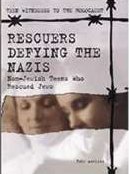 Rescuers Defying the Nazis Non-Jewish Teens Who Rescued Jews By Toby Axelrod |
Very few non-Jews risked their own lives to save the lives of Jews targeted for death by the Nazis. This book relates the inspiring stories of some of these courageous teen rescuers.
By amplifying the individual voices of teenagers directly affected by the Holocuast, these books give memorable witness to a defining period in European history. |
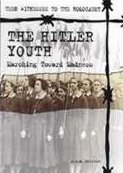 The Hitler Youth Marching Toward Madness By Alexa Dvorson |
Hundreds of thousands of German boys and girls joined the Hitler Youth, the Nazi youth organization. This volume examines how they were seduced into obeying the Nazis and how their dream was finally shattered.
By amplifying the individual voices of teenagers directly affected by the Holocuast, these books give memorable witness to a defining period in European history. |
 The Nuremberg Nazi War Crimes Trials By Harvey Fireside |
In this overly ambitious effort, Fireside attempts to describe the need for,
the preparation of, and the execution of the Nuremberg War Crimes Trials
following World War II. The result is only partially successful since it
is very difficult to analyze the conduct of six years of war, the assembling
of facts and testimonies, and the actual conduct of the trials in one short
volume. The book opens with a narrative based on the author's interview with
a former American soldier who helped liberate Dachau. The second chapter is
devoted to the deliberations over what should be considered a war crime and
who should be charged. Subsequent chapters describe the manner in which the
trials were arranged and conducted by the Allies. Though the defendants and
their roles in the Holocaust are briefly described, very little background
information is included and it is sometimes difficult to keep all of the
individuals straight. Unfamiliar words and terms are printed in italics and
explained in parentheses. The vintage photos are familiar ones that often
appear in other books on the era.
|